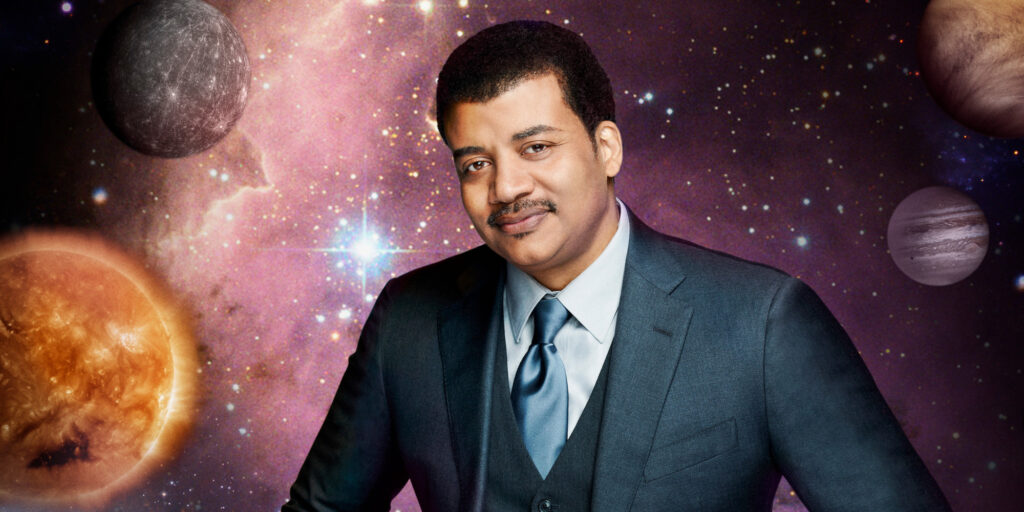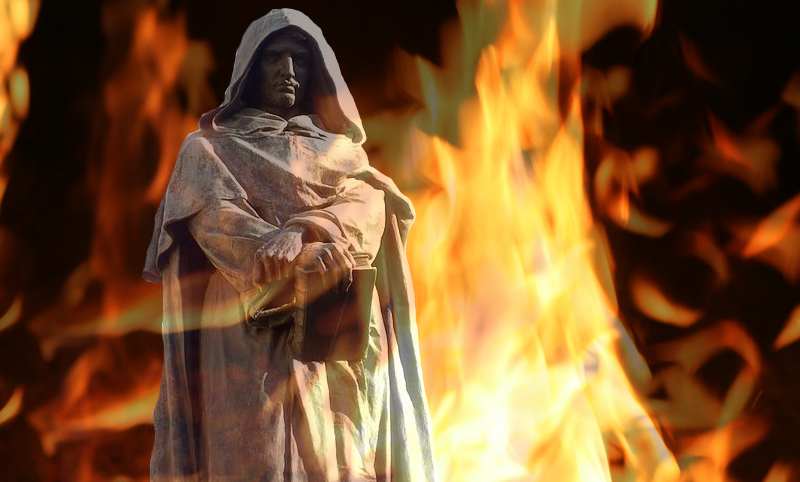Visionary experience is not unusual amongst scientists, and in the history of science. Giordano Bruno was a sixteenth century Italian Dominican friar, philosopher, mathematician, poet, and astrologer. At this time the Church was incredibly powerful, and was heavily intolerant of any challenges to its sun-and-God-centred map of the cosmos. Bruno was also a mystic who was deeply influenced by his visionary experiences. As reported in the television series Cosmos, Bruno had a powerful vision which shaped his decision to leave the Church and push for ecclesiastical reform. In the vision Bruno felt himself leaving his body, and flying out into the universe. There he felt he personally witnessed the limitless nature of the cosmos. What he experienced convinced him that Copernicus was right in positing the sun at the centre of the universe. The precise account of Bruno’s vision is difficult to track down, but Cosmos recounts it as follows.
I spread confident wings to space and soared toward the infinite, leaving far behind me what others strained to see from a distance. Here, there was no up. No down. No edge. No centre. I saw that the Sun was just another star. And the stars were other Suns, each escorted by other Earths like our own. The revelation of this immensity was like falling in love.
Thus Bruno became convinced that the God of the Church was far smaller than the extant God of all existence. He believed that the sun was just one of many stars, and speculated that many worlds might lie beyond the Earth and that they too might be inhabited. This got Bruno into a lot of trouble, and he was imprisoned for eight years as a heretic, before being cruelly burnt at the stake by the Inquisition. It is said that his tongue and pallet were pierced with iron stakes. Despite years of persecution, Bruno refused to renounce his beliefs, famously stating to his inquisitors, “Perhaps your fear in passing judgment on me is greater than mine in receiving it.”

Neil De Grasse Tyson recounts this tale in the first episode of the Cosmos series. What interests me most is de Grasse Tyson’s take on Bruno’s vision. He states that it was “…a lucky guess, and like all guesses it could have been wrong.” It is significant to note that the world’s most eminent scientist understands so little about the way the human mind functions in non-ordinary states of consciousness.
There are two factors which challenge the claim that what Bruno experienced was merely a lucky guess. The first factor is perfectly accepted in cognitive science, and it is the process of incubation. The brain will unconsciously process information on a subject matter even when we are not paying attention, when completely relaxed, or when focusing upon something unrelated. We receive immense amounts of data each moment, and we are unaware of most of it. The brain can go about processing this data, regardless of our conscious volition. The result can be personal insight, the synthesis of connected subject matters and creative inspiration. If we consider this incubation process, the relative accuracy of Bruno’s visionary experience may have been the result of his brain taking in all the data it had received, and converting it into the best map of the universe it knew how to construct. And given that Bruno was an obsessive reader of science, philosophy and theology, this vision would have been anything but a “guess.” It would have been a data-based intuition.
The second important cognitive function that challenges de Grasse Tyson’s “guess” statement concerns a factor that is not yet widely accepted in modern science: that consciousness is not confined to the brain and is in constant interplay with the world about us, and the very expanse of the universe itself. If we accept this, then Bruno’s mind was not delimited by his personal experience, including readings of science. What he “saw” in his visionary state may have been his mind engaging the intelligence of the cosmos itself. Such experiences are widely reported amongst mystics in many spiritual traditions and in transpersonal experience, although the nature of the knowledge they glean may not always be along the “scientific” lines that Bruno experienced. The history of science has many similar reports. Kekule envisaged the benzene ring in a dream, while Alfred Russel Wallace pieced together the essence of his model of biological evolution while in a fever-induced trance. Wallace did this at the very same time in history that Darwin was finalising his ideas about evolution. In fact, there are claims that Darwin plagiarised parts of his thesis from a long letter sent to him by Wallace, just months before Darwin published The Origin of Species.
It cannot be claimed that de Grasse Tyson is entirely contemptuous of the importance of first-person experience when conducting science. He describes himself as an “agnostic,” and rejects the label of “atheist.” Further, he uses the word “spiritual” in relating his emotive relationship to the cosmos. Yet he makes it clear that he is not referring to religious experience, but a sense of awe and connectivity.
Nonetheless, the famous scientist’s rejection of Bruno’s visionary capacities is perplexing. How is it possible that such a learned man as de Grasse Tyson, extensively educated and employed at the world’s finest universities (Harvard, Columbia, Princeton) can be so dismissive of the often unconscious nature of perception and creativity via non-ordinary states of consciousness? We could mention the self-limiting nature of the mechanistic paradigm in mainstream science. We might suggest the pressure that the series producers may have felt to please their “scientifically-literate” audience. Yet the answer may simply be that the world’s most eminent scientist has never experienced such states of awareness. After all, our “best” educational institutions also tend to be our most conservative. Science is taught and conducted with logical, detached and analytical ways of knowing.
The great irony is that the scientific revolution which Bruno helped bring about and ultimately died for has also disowned the very cognitive process which drove many of his insights. This rejection has created the split in the modern mind, where we disown our essential connection to nature and the cosmos, and to our inner worlds.
Perhaps we need another Bruno to rise like a phoenix from the flames of history and reignite our integrated intelligence.
Marcus








1 thought on “Extinguishing Bruno’s Visions”
That someone might be Dr John Demartini. I urge you to attend one of his lectures.